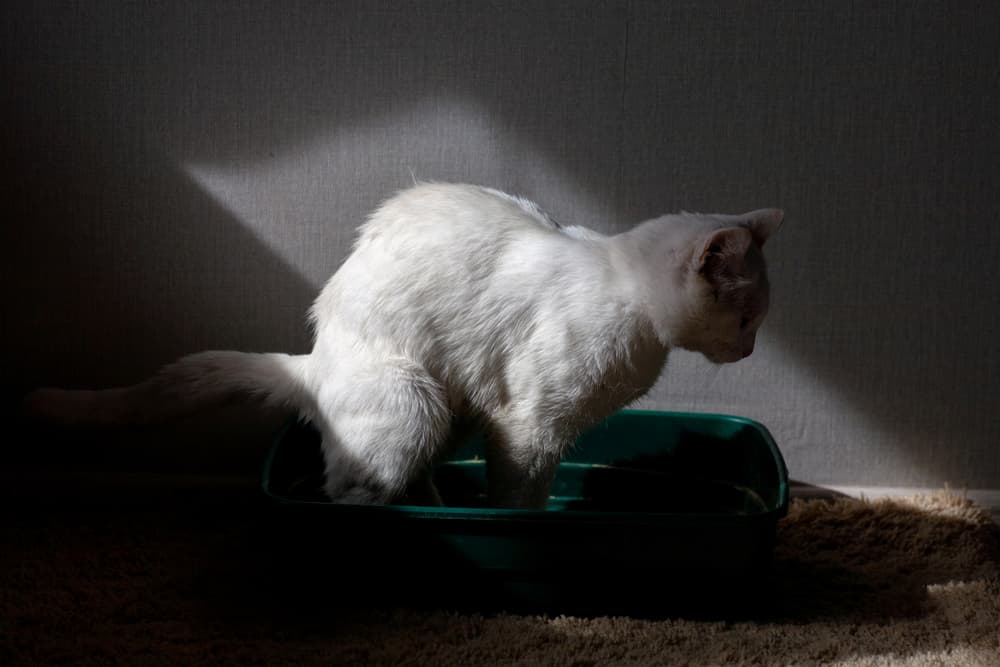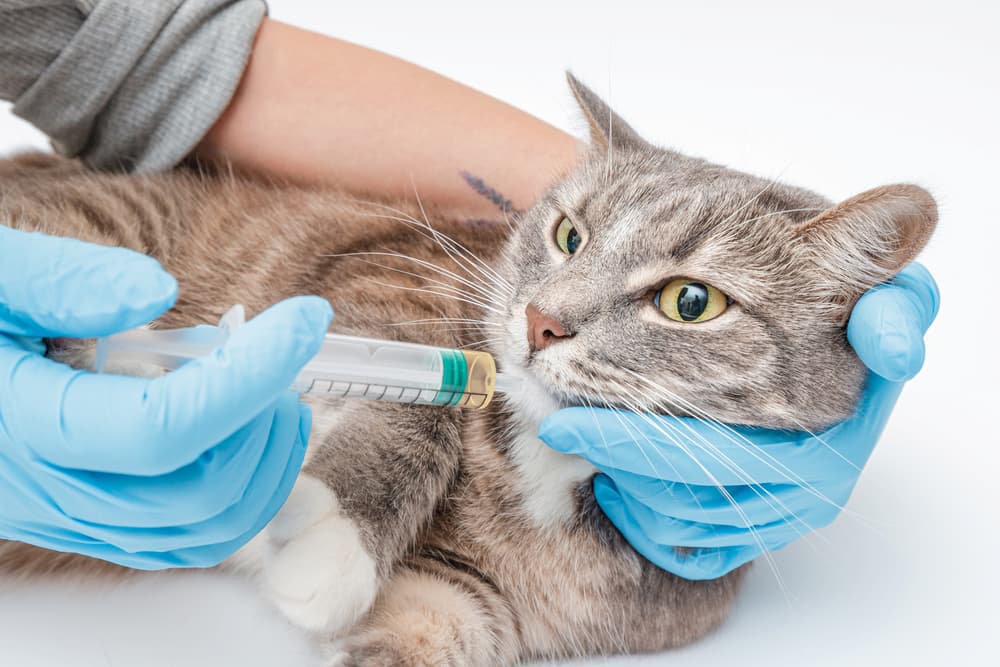Lactulose for Cats

Medication details
- Medication type: Laxative
- Form: Powder, Oral solution
- Prescription required? Yes
- FDA approved? No
- Brand names: Cephulac, Cholac, Chronulac, Constilac, Constulose, Enulose, Kristalose
- Common names: Lactulose
- Available dosages: 10 grams per 15 ml, 20 gram packet
- Expiration range: 3 years
If your cat has been diagnosed with constipation or hepatic encephalopathy (a complication of severe liver disease), your veterinarian may prescribe cat lactulose for treatment. Lactulose has two very different effects on your cat’s intestinal tract, making it an effective option for treating either of these two serious medical conditions.
Read on to learn more about lactulose for cats, and why your veterinarian might prescribe this medication to your feline companion.
What is Lactulose?
Lactulose is a synthetic (man-made) sugar. It is made by combining two natural sugars: galactose (a component of lactose, the sugar found in milk) and fructose (a sugar found in fruits). When these two sugars are combined to create lactulose, they can be used to treat both constipation and hepatic encephalopathy.
Lactulose was first developed in 1929. However, it was not considered for medicinal use until the 1960s, when it was found to be an effective treatment for constipation and hepatic encephalopathy. Lactulose received FDA approval for use in human patients in 1977, and it is widely used off-label in veterinary patients. While the FDA has not formally studied or approved the use of lactulose in cats, this medication has been extensively researched and is widely used.
Most veterinary practices keep lactulose in stock for their canine and feline patients. It may be administered to hospitalized pets in the veterinary hospital and it is often dispensed for clients to administer at home. If your veterinarian does not have this medication in stock when your pet needs it, they will write a prescription for it. This prescription will allow you to obtain lactulose from any human pharmacy.
Lactulose should not be confused with Miralax. While both medications are laxatives and they work in a similar manner, lactulose and Miralax contain different chemical ingredients. Additionally, Miralax is available over-the-counter, while lactulose is available only with a prescription.
Lactulose is available in both generic and brand-name forms.
What Does Lactulose Look Like?
Lactulose is typically administered as an oral solution, which is clear yellow in color. A powdered or crystal form is also available, which can be added to your cat’s food.
How Does Lactulose Work?
Lactulose is a synthetic sugar that cannot be digested or absorbed through the intestines. When your cat ingests lactulose, it passes unchanged through most of your cat’s gastrointestinal tract.
When lactulose reaches your cat’s colon, the normal colonic bacteria metabolize the lactulose. This metabolism creates a number of acids, including lactic acid, acetic acid, and formic acid.
The acids that are formed in your cat’s colon play two roles: they pull water into the colon, and they pull ammonia into the colon. Additional water in your cat’s colon results in softer stools, allowing lactulose to effectively treat constipation. Additional ammonia in your cat’s colon means this ammonia is removed from the bloodstream, minimizing the impacts of hepatic encephalopathy associated with liver disease.
What Is Lactulose Used For in Cats?

Lactulose is most commonly used to treat constipation in cats. It helps promote soft, frequent bowel movements, preventing fecal impactions. Feline constipation can have a number of underlying causes, including:
- Megacolon (a colon motility disorder)
- Inflammatory bowel disease
- Colonic tumors
- Anal sac disease
- Arthritis pain
- Anxiety
- Overgrooming
- Dehydration
- Kidney disease
- Hyperthyroidism
- Diabetes mellitus
Lactulose can also be used to remove ammonia from the blood. Cats with severe, end-stage liver disease do not clear ammonia from their blood effectively, and the accumulation of ammonia can lead to a neurologic condition known as hepatic encephalopathy.
In most cases, cats that are started on lactulose for constipation or liver disease will remain on lactulose for cats long-term.
The most common side effect associated with lactulose is diarrhea. However, cats may also experience a variety of other gastrointestinal signs.
Lactulose for Cats Side Effects
Side effects associated with lactulose include:
- Flatulence (gas)
- Bloating
- Abdominal cramping
- Diarrhea
- Dehydration
In general, side effects tend to be worse when a cat is first started on lactulose. As your cat acclimates to the medication, you can expect to see a decrease in bloating, gas, and abdominal cramping.
Diarrhea, however, may indicate that a change in lactulose dosing is needed. If your cat develops diarrhea while taking lactulose, ensure that they have access to plenty of water (to prevent dehydration) and contact your veterinarian for guidance.
Reactions With Other Drugs and Medications
Using lactulose with antibiotics could theoretically decrease its efficacy, by affecting the bacteria that metabolize lactulose in the colon. In practice, this does not appear to be problematic. However, it’s still best to talk to your veterinarian before combining lactulose with any antibiotics.
Do not combine lactulose with other laxatives, unless directed to do so by your veterinarian. This could cause significant diarrhea.
Finally, lactulose should not be combined with antacids in cats with hepatic encephalopathy. Combining these two drugs could reduce the efficacy of lactulose.
Lactulose for Cats Dosage

Your veterinarian will determine an appropriate starting dose of lactulose for your cat. The lactulose dose for cats is calculated based on your cat’s weight and medical condition. This dose will initially be given every 8-12 hours.
As you and your veterinarian assess your cat’s response to treatment, your cat’s dosage may be changed. Your veterinarian may increase or decrease your cat’s lactulose dosage, depending on how your cat’s medical issues respond to treatment.
What If You Miss a Lactulose Dose for Cats?
If you miss a dose of your cat’s lactulose, give the missed dose as soon as you remember. If it is almost time for your cat’s next dose of lactulose, skip the missed dose and continue giving lactulose on your cat’s regular dosing schedule. Do not give your pet two doses of this medication at once.
Cost of Lactulose for Cats
Both the generic and brand-name forms of lactulose are relatively inexpensive. The cost of treating your cat will depend on their medication dosing requirements, but most cat owners will spend less than $40 per month on lactulose.
Lactulose Storage Instructions
This medication should be stored at room temperature, with the container tightly closed. Do not freeze this medication. Keep this medication out of the reach of children.









